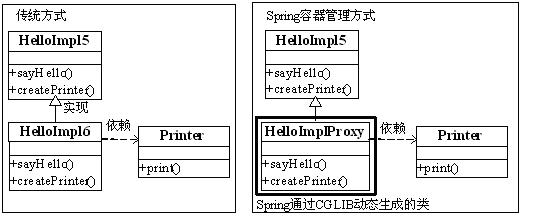3.3.1 延迟初始化Bean
延迟初始化也叫做惰性初始化,指不提前初始化Bean,而是只有在真正使用时才创建及初始化Bean。
配置方式很简单只需在<bean>标签上指定 “lazy-init” 属性值为“true”即可延迟初始化Bean。
Spring容器会在创建容器时提前初始化“singleton”作用域的Bean,“singleton”就是单例的意思即整个容器每个Bean只有一个实例,后边会详细介绍。Spring容器预先初始化Bean通常能帮助我们提前发现配置错误,所以如果没有什么情况建议开启,除非有某个Bean可能需要加载很大资源,而且很可能在整个应用程序生命周期中很可能使用不到,可以设置为延迟初始化。
延迟初始化的Bean通常会在第一次使用时被初始化;或者在被非延迟初始化Bean作为依赖对象注入时在会随着初始化该Bean时被初始化,因为在这时使用了延迟初始化Bean。
容器管理初始化Bean消除了编程实现延迟初始化,完全由容器控制,只需在需要延迟初始化的Bean定义上配置即可,比编程方式更简单,而且是无侵入代码的。
具体配置如下:
<bean id="helloApi" class="cn.javass.spring.chapter2.helloworld.HelloImpl" lazy-init="true"/>
3.3.2 使用depends-on
depends-on是指指定Bean初始化及销毁时的顺序,使用depends-on属性指定的Bean要先初始化完毕后才初始化当前Bean,由于只有“singleton”Bean能被Spring管理销毁,所以当指定的Bean都是“singleton”时,使用depends-on属性指定的Bean要在指定的Bean之后销毁。
配置方式如下:
<bean id="helloApi" class="cn.javass.spring.chapter2.helloworld.HelloImpl"/>
<bean id="decorator"
class="cn.javass.spring.chapter3.bean.HelloApiDecorator"
depends-on="helloApi">
<property name="helloApi"><ref bean="helloApi"/></property>
</bean>
“depends-on”属性可以指定多个Bean,若指定多个Bean可以用“;”、“,”、空格分割。
那“depends-on”有什么好处呢?主要是给出明确的初始化及销毁顺序,比如要初始化“decorator”时要确保“helloApi”Bean的资源准备好了,否则使用“decorator”时会看不到准备的资源;而在销毁时要先在“decorator”Bean的把对“helloApi”资源的引用释放掉才能销毁“helloApi”,否则可能销毁 “helloApi”时而“decorator”还保持着资源访问,造成资源不能释放或释放错误。
让我们看个例子吧,在平常开发中我们可能需要访问文件系统,而文件打开、关闭是必须配对的,不能打开后不关闭,从而造成其他程序不能访问该文件。让我们来看具体配置吧:
1)准备测试类:
ResourceBean从配置文件中配置文件位置,然后定义初始化方法init中打开指定的文件,然后获取文件流;最后定义销毁方法destroy用于在应用程序关闭时调用该方法关闭掉文件流。
DependentBean中会注入ResourceBean,并从ResourceBean中获取文件流写入内容;定义初始化方法init用来定义一些初始化操作并向文件中输出文件头信息;最后定义销毁方法用于在关闭应用程序时想文件中输出文件尾信息。
具体代码如下:
package cn.javass.spring.chapter3.bean;
import java.io.File;
import java.io.FileNotFoundException;
import java.io.FileOutputStream;
import java.io.IOException;
public class ResourceBean {
private FileOutputStream fos;
private File file;
//初始化方法
public void init() {
System.out.println("ResourceBean:========初始化");
//加载资源,在此只是演示
System.out.println("ResourceBean:========加载资源,执行一些预操作");
try {
this.fos = new FileOutputStream(file);
} catch (FileNotFoundException e) {
e.printStackTrace();
}
}
//销毁资源方法
public void destroy() {
System.out.println("ResourceBean:========销毁");
//释放资源
System.out.println("ResourceBean:========释放资源,执行一些清理操作");
try {
fos.close();
} catch (IOException e) {
e.printStackTrace();
}
}
public FileOutputStream getFos() {
return fos;
}
public void setFile(File file) {
this.file = file;
}
}
package cn.javass.spring.chapter3.bean;
import java.io.IOException;
public class DependentBean {
ResourceBean resourceBean;
public void write(String ss) throws IOException {
System.out.println("DependentBean:=======写资源");
resourceBean.getFos().write(ss.getBytes());
}
//初始化方法
public void init() throws IOException {
System.out.println("DependentBean:=======初始化");
resourceBean.getFos().write("DependentBean:=======初始化=====".getBytes());
}
//销毁方法
public void destroy() throws IOException {
System.out.println("DependentBean:=======销毁");
//在销毁之前需要往文件中写销毁内容
resourceBean.getFos().write("DependentBean:=======销毁=====".getBytes());
}
public void setResourceBean(ResourceBean resourceBean) {
this.resourceBean = resourceBean;
}
}
2)类定义好了,让我们来进行Bean定义吧,具体配置文件如下:
<bean id="resourceBean"
class="cn.javass.spring.chapter3.bean.ResourceBean"
init-method="init" destroy-method="destroy">
<property name="file" value="D:/test.txt"/>
</bean>
<bean id="dependentBean"
class="cn.javass.spring.chapter3.bean.DependentBean"
init-method="init" destroy-method="destroy" depends-on="resourceBean">
<property name="resourceBean" ref="resourceBean"/>
</bean>
<property name="file" value="D:/test.txt"/>配置:Spring容器能自动把字符串转换为java.io.File。
init-method="init" :指定初始化方法,在构造器注入和setter注入完毕后执行。
destroy-method="destroy":指定销毁方法,只有“singleton”作用域能销毁,“prototype”作用域的一定不能,其他作用域不一定能;后边再介绍。
在此配置中,resourceBean初始化在dependentBean之前被初始化,resourceBean销毁会在dependentBean销毁之后执行。
3)配置完毕,测试一下吧:
package cn.javass.spring.chapter3;
import java.io.IOException;
import org.junit.Test;
import org.springframework.context.support.ClassPathXmlApplicationContext;
import cn.javass.spring.chapter3.bean.DependentBean;
public class MoreDependencyInjectTest {
@Test
public void testDependOn() throws IOException {
ClassPathXmlApplicationContext context =
new ClassPathXmlApplicationContext("chapter3/depends-on.xml");
//一点要注册销毁回调,否则我们定义的销毁方法不执行
context.registerShutdownHook();
DependentBean dependentBean =
context.getBean("dependentBean", DependentBean.class);
dependentBean.write("aaa");
}
}
测试跟其他测试完全一样,只是在此我们一定要注册销毁方法回调,否则销毁方法不会执行。
如果配置没问题会有如下输出:
ResourceBean:========初始化
ResourceBean:========加载资源,执行一些预操作
DependentBean:=========初始化
DependentBean:=========写资源
DependentBean:=========销毁
ResourceBean:========销毁
ResourceBean:========释放资源,执行一些清理操作
3.3.3 自动装配
自动装配就是指由Spring来自动地注入依赖对象,无需人工参与。
目前Spring3.0支持“no”、“byName ”、“byType”、“constructor”四种自动装配,默认是“no”指不支持自动装配的,其中Spring3.0已不推荐使用之前版本的“autodetect”自动装配,推荐使用Java 5+支持的(@Autowired)注解方式代替;如果想支持“autodetect”自动装配,请将schema改为“spring-beans-2.5.xsd”或去掉。
自动装配的好处是减少构造器注入和setter注入配置,减少配置文件的长度。自动装配通过配置<bean>标签的“autowire”属性来改变自动装配方式。接下来让我们挨着看下配置的含义。
一、default:表示使用默认的自动装配,默认的自动装配需要在<beans>标签中使用default-autowire属性指定,其支持“no”、“byName ”、“byType”、“constructor”四种自动装配,如果需要覆盖默认自动装配,请继续往下看;
二、no:意思是不支持自动装配,必须明确指定依赖。
三、byName:通过设置Bean定义属性autowire="byName",意思是根据名字进行自动装配,只能用于setter注入。比如我们有方法“setHelloApi”,则“byName”方式Spring容器将查找名字为helloApi的Bean并注入,如果找不到指定的Bean,将什么也不注入。
例如如下Bean定义配置:
<bean id="helloApi" class="cn.javass.spring.chapter2.helloworld.HelloImpl"/>
<bean id="bean" class="cn.javass.spring.chapter3.bean.HelloApiDecorator"
autowire="byName"/>
测试代码如下:
package cn.javass.spring.chapter3;
import java.io.IOException;
import org.junit.Test;
import org.springframework.context.support.ClassPathXmlApplicationContext;
import cn.javass.spring.chapter2.helloworld.HelloApi;
public class AutowireBeanTest {
@Test
public void testAutowireByName() throws IOException {
ClassPathXmlApplicationContext context =
new ClassPathXmlApplicationContext("chapter3/autowire-byName.xml");
HelloApi helloApi = context.getBean("bean", HelloApi.class);
helloApi.sayHello();
}
}
是不是不要配置<property>了,如果一个bean有很多setter注入,通过“byName”方式是不是能减少很多<property>配置。此处注意了,在根据名字注入时,将把当前Bean自己排除在外:比如“hello”Bean类定义了“setHello”方法,则hello是不能注入到“setHello”的。
四、“byType”:通过设置Bean定义属性autowire="byType",意思是指根据类型注入,用于setter注入,比如如果指定自动装配方式为“byType”,而“setHelloApi”方法需要注入HelloApi类型数据,则Spring容器将查找HelloApi类型数据,如果找到一个则注入该Bean,如果找不到将什么也不注入,如果找到多个Bean将优先注入<bean>标签“primary”属性为true的Bean,否则抛出异常来表明有个多个Bean发现但不知道使用哪个。让我们用例子来讲解一下这几种情况吧。
1)根据类型只找到一个Bean,此处注意了,在根据类型注入时,将把当前Bean自己排除在外,即如下配置中helloApi和bean都是HelloApi接口的实现,而“bean”通过类型进行注入“HelloApi”类型数据时自己是排除在外的,配置如下(具体测试请参考AutowireBeanTest.testAutowireByType1方法):
<bean class="cn.javass.spring.chapter2.helloworld.HelloImpl"/>
<bean id="bean" class="cn.javass.spring.chapter3.bean.HelloApiDecorator" autowire="byType"/>
2)根据类型找到多个Bean时,对于集合类型(如List、Set)将注入所有匹配的候选者,而对于其他类型遇到这种情况可能需要使用“autowire-candidate”属性为false来让指定的Bean放弃作为自动装配的候选者,或使用“primary”属性为true来指定某个Bean为首选Bean:
2.1)通过设置Bean定义的“autowire-candidate”属性为false来把指定Bean后自动装配候选者中移除:
<bean class="cn.javass.spring.chapter2.helloworld.HelloImpl"/>
<!-- 从自动装配候选者中去除 -->
<bean class="cn.javass.spring.chapter2.helloworld.HelloImpl"
autowire-candidate="false"/>
<bean id="bean1" class="cn.javass.spring.chapter3.bean.HelloApiDecorator"
autowire="byType"/>
2.2)通过设置Bean定义的“primary”属性为true来把指定自动装配时候选者中首选Bean:
<bean class="cn.javass.spring.chapter2.helloworld.HelloImpl"/>
<!-- 自动装配候选者中的首选Bean-->
<bean class="cn.javass.spring.chapter2.helloworld.HelloImpl" primary="true"/>
<bean id="bean" class="cn.javass.spring.chapter3.bean.HelloApiDecorator"
autowire="byType"/>
具体测试请参考AutowireBeanTest类的testAutowireByType***方法。
五、“constructor”:通过设置Bean定义属性autowire="constructor",功能和“byType”功能一样,根据类型注入构造器参数,只是用于构造器注入方式,直接看例子吧:
<bean class="cn.javass.spring.chapter2.helloworld.HelloImpl"/>
<!-- 自动装配候选者中的首选Bean-->
<bean class="cn.javass.spring.chapter2.helloworld.HelloImpl" primary="true"/>
<bean id="bean"
class="cn.javass.spring.chapter3.bean.HelloApiDecorator"
autowire="constructor"/>
测试代码如下:
@Test
public void testAutowireByConstructor() throws IOException {
ClassPathXmlApplicationContext context =
new ClassPathXmlApplicationContext("chapter3/autowire-byConstructor.xml");
HelloApi helloApi = context.getBean("bean", HelloApi.class);
helloApi.sayHello();
}
3.3.5 方法注入
所谓方法注入其实就是通过配置方式覆盖或拦截指定的方法,通常通过代理模式实现。Spring提供两种方法注入:查找方法注入和方法替换注入。
因为Spring是通过CGLIB动态代理方式实现方法注入,也就是通过动态修改类的字节码来实现的,本质就是生成需方法注入的类的子类方式实现。
在进行测试之前,我们需要确保将“com.springsource.cn.sf.cglib-2.2.0.jar”放到lib里并添加到“Java Build Path”中的Libararies中。否则报错,异常中包含“nested exception is java.lang.NoClassDefFoundError: cn/sf/cglib/proxy/CallbackFilter”。

传统方式和Spring容器管理方式唯一不同的是不需要我们手动生成子类,而是通过配置方式来实现;其中如果要替换createPrinter()方法的返回值就使用查找方法注入;如果想完全替换sayHello()方法体就使用方法替换注入。 接下来让我们看看具体实现吧。
一、查找方法注入:又称为Lookup方法注入,用于注入方法返回结果,也就是说能通过配置方式替换方法返回结果。使用<lookup-method name="方法名" bean="bean名字"/>配置;其中name属性指定方法名,bean属性指定方法需返回的Bean。
方法定义格式:访问级别必须是public或protected,保证能被子类重载,可以是抽象方法,必须有返回值,必须是无参数方法,查找方法的类和被重载的方法必须为非final:
<public|protected> [abstract] <return-type> theMethodName(no-arguments);
因为“singleton”Bean在容器中只有一个实例,而“prototype”Bean是每次获取容器都返回一个全新的实例,所以如果“singleton”Bean在使用“prototype” Bean情况时,那么“prototype”Bean由于是“singleton”Bean的一个字段属性,所以获取的这个“prototype”Bean就和它所在的“singleton”Bean具有同样的生命周期,所以不是我们所期待的结果。因此查找方法注入就是用于解决这个问题。
1) 首先定义我们需要的类,Printer类是一个有状态的类,counter字段记录访问次数:
package cn.javass.spring.chapter3.bean;
public class Printer {
private int counter = 0;
public void print(String type) {
System.out.println(type + " printer: " + counter++);
}
}
HelloImpl5类用于打印欢迎信息,其中包括setter注入和方法注入,此处特别需要注意的是该类是抽象的,充分说明了需要容器对其进行子类化处理,还定义了一个抽象方法createPrototypePrinter用于创建“prototype”Bean,createSingletonPrinter方法用于创建“singleton”Bean,此处注意方法会被Spring拦截,不会执行方法体代码:
package cn.javass.spring.chapter3;
import cn.javass.spring.chapter2.helloworld.HelloApi;
import cn.javass.spring.chapter3.bean.Printer;
public abstract class HelloImpl5 implements HelloApi {
private Printer printer;
public void sayHello() {
printer.print("setter");
createPrototypePrinter().print("prototype");
createSingletonPrinter().print("singleton");
}
public abstract Printer createPrototypePrinter();
public Printer createSingletonPrinter() {
System.out.println("该方法不会被执行,如果输出就错了");
return new Printer();
}
public void setPrinter(Printer printer) {
this.printer = printer;
}
}
2) 开始配置了,配置文件在(resources/chapter3/lookupMethodInject.xml),其中“prototypePrinter”是“prototype”Printer,“singletonPrinter”是“singleton”Printer,“helloApi1”是“singleton”Bean,而“helloApi2”注入了“prototype”Bean:
<bean id="prototypePrinter"
class="cn.javass.spring.chapter3.bean.Printer" scope="prototype"/>
<bean id="singletonPrinter"
class="cn.javass.spring.chapter3.bean.Printer" scope="singleton"/>
<bean id="helloApi1" class="cn.javass.spring.chapter3.HelloImpl5" scope="singleton">
<property name="printer" ref="prototypePrinter"/>
<lookup-method name="createPrototypePrinter" bean="prototypePrinter"/>
<lookup-method name="createSingletonPrinter" bean="singletonPrinter"/>
</bean>
<bean id="helloApi2" class="cn.javass.spring.chapter3.HelloImpl5" scope="prototype">
<property name="printer" ref="prototypePrinter"/>
<lookup-method name="createPrototypePrinter" bean="prototypePrinter"/>
<lookup-method name="createSingletonPrinter" bean="singletonPrinter"/>
</bean>
3)测试代码如下:
package cn.javass.spring.chapter3;
import org.junit.Test;
import org.springframework.context.support.ClassPathXmlApplicationContext;
import cn.javass.spring.chapter2.helloworld.HelloApi;
public class MethodInjectTest {
@Test
public void testLookup() {
ClassPathXmlApplicationContext context =
new ClassPathXmlApplicationContext("chapter3/lookupMethodInject.xml");
System.out.println("=======singleton sayHello======");
HelloApi helloApi1 = context.getBean("helloApi1", HelloApi.class);
helloApi1.sayHello();
helloApi1 = context.getBean("helloApi1", HelloApi.class);
helloApi1.sayHello();
System.out.println("=======prototype sayHello======");
HelloApi helloApi2 = context.getBean("helloApi2", HelloApi.class);
helloApi2.sayHello();
helloApi2 = context.getBean("helloApi2", HelloApi.class);
helloApi2.sayHello();
}}
其中“helloApi1”测试中,其输出结果如下:
=======singleton sayHello======
setter printer: 0
prototype printer: 0
singleton printer: 0
setter printer: 1
prototype printer: 0
singleton printer: 1
首先“helloApi1”是“singleton”,通过setter注入的“printer”是“prototypePrinter”,所以它应该输出“setter printer:0”和“setter printer:1”;而“createPrototypePrinter”方法注入了“prototypePrinter”,所以应该输出两次“prototype printer:0”;而“createSingletonPrinter”注入了“singletonPrinter”,所以应该输出“singleton printer:0”和“singleton printer:1”。
而“helloApi2”测试中,其输出结果如下:
=======prototype sayHello======
setter printer: 0
prototype printer: 0
singleton printer: 2
setter printer: 0
prototype printer: 0
singleton printer: 3
首先“helloApi2”是“prototype”,通过setter注入的“printer”是“prototypePrinter”,所以它应该输出两次“setter printer:0”;而“createPrototypePrinter”方法注入了“prototypePrinter”,所以应该输出两次“prototype printer:0”;而“createSingletonPrinter”注入了“singletonPrinter”,所以应该输出“singleton printer:2”和“singleton printer:3”。
大家是否注意到“createSingletonPrinter”方法应该输出“该方法不会被执行,如果输出就错了”,而实际是没输出的,这说明Spring拦截了该方法并使用注入的Bean替换了返回结果。
方法注入主要用于处理“singleton”作用域的Bean需要其他作用域的Bean时,采用Spring查找方法注入方式无需修改任何代码即能获取需要的其他作用域的Bean。
二、替换方法注入:也叫“MethodReplacer”注入,和查找注入方法不一样的是,他主要用来替换方法体。通过首先定义一个MethodReplacer接口实现,然后如下配置来实现:
<replaced-method name="方法名" replacer="MethodReplacer实现">
<arg-type>参数类型</arg-type>
</replaced-method>”
1)首先定义MethodReplacer实现,完全替换掉被替换方法的方法体及返回值,其中reimplement方法重定义方法 功能,参数obj为被替换方法的对象,method为被替换方法,args为方法参数;最需要注意的是不能再 通过“method.invoke(obj, new String[]{"hehe"});” 反射形式再去调用原来方法,这样会产生循环调用;如果返回值类型为Void,请在实现中返回null:
package cn.javass.spring.chapter3.bean;
import java.lang.reflect.Method;
import org.springframework.beans.factory.support.MethodReplacer;
public class PrinterReplacer implements MethodReplacer {
@Override
public Object reimplement(Object obj, Method method, Object[] args) throws Throwable {
System.out.println("Print Replacer");
//注意此处不能再通过反射调用了,否则会产生循环调用,知道内存溢出
//method.invoke(obj, new String[]{"hehe"});
return null;
}
}
2)配置如下,首先定义MethodReplacer实现,使用< replaced-method >标签来指定要进行替换方法,属性name指定替换的方法名字,replacer指定该方法的重新实现者,子标签< arg-type >用来指定原来方法参数的类型,必须指定否则找不到原方法:
<bean id="replacer" class="cn.javass.spring.chapter3.bean.PrinterReplacer"/>
<bean id="printer" class="cn.javass.spring.chapter3.bean.Printer">
<replaced-method name="print" replacer="replacer">
<arg-type>java.lang.String</arg-type>
</replaced-method>
</bean>
3)测试代码将输出“Print Replacer ”,说明方法体确实被替换了:
@Test
public void testMethodReplacer() {
ClassPathXmlApplicationContext context = new ClassPathXmlApplicationContext("chapter3/methodReplacerInject.xml");
Printer printer = context.getBean("printer", Printer.class);
printer.print("我将被替换");
}





















 153
153











 被折叠的 条评论
为什么被折叠?
被折叠的 条评论
为什么被折叠?








